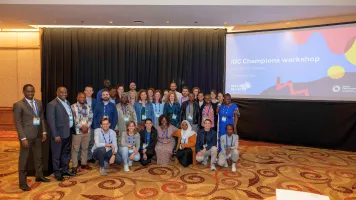Although COVID-19 poses higher risks to children who live or work on the street, it is not the biggest threat they face in 2020. These children often have high rates of respiratory infections, including pneumonia, and existing health conditions such as asthma, but the lockdowns designed to curtail the spread of the virus have become a far greater threat. Lockdowns have aggravated pre-existing vulnerabilities of the poorest populations. Even if governments provide relief to some of these groups, street-connected children are invisible in official data, and thus don’t receive the support they need.
Around the world, street-connected children – those who live or work on or have another strong connection to the street – depend on the everyday hustle and bustle of towns and cities to survive. As the pandemic began to gather speed in March and April 2020, governments sent their populations into lockdown, often without planning for how this public health response would affect their most marginalised citizens.
Typically, crowded streets suddenly fell quiet, emptied of everyone except for those who had nowhere to go. Usually an unnoticed feature of urban life, children who live on the streets - often far from their places of origin or in informal settlements where physical distancing is impossible - were simply unable to shelter indoors. Children in many countries have faced retribution from law enforcement for failing to obey lockdown and curfew orders. In many cases, however, hunger is their main concern. With their usual sources of food and money completely dried up, street-connected children around the world are struggling to find anything to eat. With even fewer options for survival than usual, Consortium for Street Children (CSC) network members are concerned children are being forced to turn to even more dangerous survival tactics. Others are attempting to walk hundreds of miles to their rural homes.
Although we know street-connected children are ubiquitous, no one knows exactly how many there are because standard data collection methods do not reach them. Household surveys that form the basis of most national data collection exercises miss anyone who lives on the streets or outside of typical household structures. Small scale data collection efforts use different approaches, methodologies, and definitions (such as excluding children who work but don’t sleep on the street) so data cannot be compared across locations or over time. The pandemic did not cause any of these issues. Instead, it has brought the practical consequences of street children’s invisibility in data starkly into focus.
Some governments have dispersed limited emergency relief to their starving populations who have lost their livelihood during lockdowns. Yet street-connected children are too often unable to access it. Many of these children either were not registered at birth or do not have access to their identity documents. To the state, they are invisible. Before the pandemic, this made it difficult or impossible for many to access healthcare, education, and other state services. Under lockdown, a lack of ID can mean the difference between having food to eat and starving as governments from Pakistan and India to Uganda required official documents to access support. We do not know how many street children are affected due to the scarcity of data.
Today, many countries are beginning to re-open, despite ever-growing COVID-19 cases, recognising that lockdowns are unsustainable where large portions of the population work in the informal economy and live below the poverty line. Little has changed for street children, who continue to struggle to survive. But there are opportunities coming from the pandemic. Governments around the world have taken note (if not action), forced to recognise that their systems are not designed to support the most vulnerable people. A lack of reliable data about these groups means that governments do not know how many people are in desperate need of aid, where they are located, or who is being left out.
How do we ensure street-connected children are accounted for in future responses?
We must work together to develop data collection methods that are specifically designed to capture information about street-connected children. These methods need to be standardised so that we can develop accurate national and global understandings of street-connected children’s lives and compare this over time. This needs to go further than making household surveys and censuses more inclusive. The small number of street and other hidden children that would be included in a sample frame of a census would not allow for the disaggregation of data by gender or age groups or context-specific dimensions. Specific methods are also needed to illuminate the realities of street-connected children’s lives and to tailor interventions – including emergency relief during crises such as the pandemic - to their specific needs, recognising that all street children have different stories. Only by including street-connected children in official data can we ensure that these government responses reach those who need the support the most.


